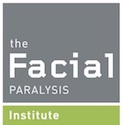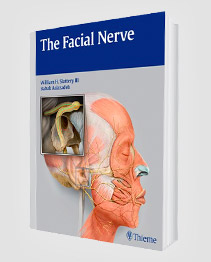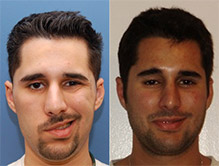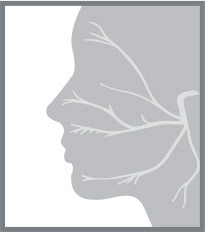Pediatric Bell’s palsy can cause facial paralysis in children from infancy to adolescence. Dr. Babak Azizzadeh of The Facial Paralysis Institute understands the challenges associated with Bell’s palsy in childhood. He offers Botox and surgical treatments to treat Bell’s palsy.
What Is Bell’s Palsy?
Bell’s palsy is one of the primary causes of facial paralysis in the United States. It is named after Sir Charles Bell, a neurologist and anatomist who discovered the condition.
Temporary facial paralysis occurs in approximately 85% of patients diagnosed with Bell’s palsy. In the other 15% of patients, Bell’s palsy may be permanent or result in synkinesis.
Bell’s palsy impacts roughly 40,000 Americans each year, according to the National Institute of Neurological Disorders and Stroke. However, Bell’s palsy is less common in individuals under the age of 15 and over the age of 60.
What Is Facial Nerve Palsy in Children?
Pediatric Bell’s palsy is a form of facial paralysis that occurs in childhood. Generally, Bell’s palsy in kids results in sudden facial paralysis. It can cause a child to experience a feeling or sensation in the face that hampers their ability to make facial expressions.
Causes of Bell’s Palsy in Children
There are over 100 known causes of Bell’s palsy in kids. These causes include:
-
- Salivary gland inflammation
- Trauma
- Tumors
The causes of Bell’s palsy in kids can be congenital (due to delivery trauma or genetic or malformative diseases) or acquired (due to infection, inflammation or other traumatic causes).
Difference Between Pediatric Bell’s Palsy and Congenital Facial Paralysis
Pediatric Bell’s palsy can cause weakness and drooping on one side of the face. Children with Bell’s palsy may be unable to close the eye on the affected side of the face. They may also have trouble smiling, frowning, or making other facial expressions. In some instances, Bell’s palsy in kids affects the entire face.
Facial nerve palsy in children is often temporary, with symptoms that typically resolve on their own within a few months of onset. Patients can experience Bell’s palsy symptoms that begin during childhood and recur over time.
Congenital facial paralysis is a form of facial palsy that affects children at birth. It is a rare condition that can make it difficult for a newborn to nurse and/or completely close the eyes. If congenital facial paralysis goes untreated and does not resolve on its own, it can affect a child’s development relative to speech and emotional expression.
In many instances, children may experience several disorders in conjunction with congenital facial paralysis, including:
-
- Cleft palate
- Deformed extremities
- Microtia
A child who experiences sudden facial paralysis should go to the emergency room for immediate diagnosis. Most facial paralysis symptoms in kids will disappear on their own within a few days or weeks.
If a child experiences facial paralysis symptoms that last for eight months or longer, meet with Dr. Azizzadeh. Dr. Azizzadeh is a world-renowned facial plastic and reconstructive surgeon with many years of experience. He can evaluate facial paralysis patients and treat their symptoms.
Is Bell’s Palsy in Children Preventable?
Bell’s palsy in children cannot be prevented, but treatment options are available. Children with Bell’s palsy who receive immediate treatment are well-equipped to manage the condition’s symptoms.
Parents should watch for Bell’s palsy symptoms in kids. Those who understand the symptoms of facial nerve palsy in children can identify them in their early stages. They can then meet with a doctor who can evaluate children and determine if they are dealing with Bell’s palsy.
Pediatric Bell’s Palsy Symptoms
Bell’s palsy symptoms can vary based on the child and can range from mild facial weakness to total facial paralysis.
Common symptoms of Bell’s palsy in kids include:
-
- Inability to close the eye on one side of the face
- Weakness in the upper and lower portions of the face
- Unilateral drooping of the corner of one side of the mouth
- Loss of nasolabial fold
- Pain around the ear and nearby areas
- Ringing in one or both ears
- Headache
- Loss of taste
- Sensitivity to sound on the affected side of the face
- Impaired speech
- Dizziness
- Difficulty eating or drinking
Parents who notice any of these symptoms should take their child to an emergency room to receive a medical evaluation and treatment. If Bell’s palsy symptoms persist for more than eight months or longer, Dr. Azizzadeh can assess a child and provide a treatment recommendation.
Treatments for Facial Nerve Palsy in Children
Dr. Azizzadeh offers many facial reanimation treatment options to children dealing with facial nerve palsy. He requests a consultation to learn about a patient and their pediatric Bell’s palsy symptoms.
Bell’s palsy in children can be difficult to diagnose, and Dr. Azizzadeh devotes the time necessary to learn as much as he can about his patient. Dr. Azizzadeh assesses his patient’s facial paralysis symptoms and finds out how long they have been present. He also reviews his patient’s medical history.
After a consultation, Dr. Azizzadeh can determine the best course of action to treat a child’s Bell’s palsy symptoms. Dr. Azizzadeh customizes a treatment plan to his pediatrc Bell’s palsy patient. He details all aspects of the plan to his patient and their parents. Together, Dr. Azizzadeh, his patient, and their parents can execute this plan to achieve the optimal treatment results.
Pediatric Bell’s Palsy FAQs
How long does Bell’s palsy last in children?
Oftentimes, Bell’s palsy symptoms disappear on their own within about three months of onset. In rare instances, Bell’s palsy symptoms do not disappear.
If pediatric Bell’s palsy causes unilateral facial paralysis for eight months or longer, consult with Dr. Azizzadeh. At this point, Dr. Azizzadeh can evaluate a child’s Bell’s palsy symptoms and offer a personalized treatment recommendation.
Dr. Azizzadeh has a simple goal: to treat a Bell’s palsy patient’s facial paralysis symptoms. If a child has been dealing with Bell’s palsy for an extended period of time, Dr. Azizzadeh works diligently to help this child quickly address their symptoms.
What should I do if my child has Bell’s palsy?
If your child has Bell’s palsy, there is no need to panic. Most Bell’s palsy cases resolve on their own over the course of a few months. If Bell’s palsy symptoms persist, set up a consultation with Dr. Azizzadeh.
Dr. Azizzadeh is a Harvard-trained and dual board-certified facial plastic and reconstructive surgeon who provides comprehensive pediatric Bell’s palsy treatments. He works with children dealing with Bell’s palsy to safely treat their facial paralysis symptoms.
What causes Bell’s palsy in infants?
Bell’s palsy in infants occurs due to facial nerve damage related to a virus, injury, flu, ear infection, or diabetes. Additionally, Lyme disease has been linked to Bell’s palsy in children.
Is pediatric Bell’s palsy a recurring issue?
Research indicates there is a 7% recurrence rate of Bell’s palsy symptoms. Pediatric Bell’s palsy treatments are designed to help children prevent facial paralysis symptoms from recurring. By following treatment instructions closely, children can minimize the risk of ongoing Bell’s palsy symptoms.
How can I help my child who is currently dealing with Bell’s palsy?
Living with Bell’s palsy is difficult, particularly for children. Parents should provide constant support to kids dealing with Bell’s palsy. This can help children manage anger, sadness, frustration, and other feelings commonly associated with the condition. Also, parents must preach patience as a child undergoes a Bell’s palsy treatment, since the time it takes to resolve Bell’s palsy symptoms varies.
Dr. Azizzadeh is happy to meet with a child dealing with Bell’s palsy and their parents. He can respond to pediatric Bell’s palsy concerns and questions.
Schedule a Consultation with Dr. Azizzadeh of the Facial Paralysis Institute Today
Recurrent Bell’s palsy symptoms in children can be problematic. Dr. Azizzadeh offers expert insights into Bell’s palsy in kids. He can evaluate a child’s Bell’s palsy symptoms and offer a solution to alleviate them. Dr. Azizzadeh can also help parents and kids work together to ensure a pediatric Bell’s palsy treatment delivers long-lasting results.
To find out more about the Facial Paralysis Institute and how we treat Bell’s palsy in children and adults, please contact us online or call us today at (310) 657-2203 to set up an appointment.
Request your consultation with Dr. Azizzadeh today
Call us at (310) 657-2203 to schedule an appointment.
Schedule a Consultation




